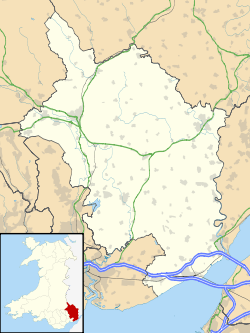St Cybi's Church, Llangybi, Monmouthshire
The Church of St Cybi, Llangybi, Monmouthshire is a parish church with its origins in the 13th or 14th century. Refurbished in the 15th century, the church was restored in 1909-10. The interior has a notable collection of medieval wall paintings, in particular a Christ of the Trades, dating from c.1460. The church, although an active parish church, is currently closed for a significant repair programme. It is a Grade II* listed building and the architectural writer John Newman, recording the church in the Buildings of Wales series, described it as "one of the most interesting in the Usk Valley."
| St Cybi's Church, Llangybi, Monmouthshire | |
|---|---|
| Church of St Cybi | |
 The entrance and tower | |
 St Cybi's Church, Llangybi, Monmouthshire Location in Monmouthshire | |
| Location | Llangybi, Monmouthshire |
| Country | Wales |
| Denomination | Church in Wales |
| History | |
| Status | Parish church |
| Founded | C13th-C14th century |
| Architecture | |
| Functional status | Active |
| Heritage designation | Grade II* |
| Designated | 18 November 1980 |
| Architectural type | Church |
| Administration | |
| Parish | Llangybi |
| Deanery | Raglan/Usk |
| Archdeaconry | Monmouth |
| Diocese | Monmouth |
| Clergy | |
| Vicar(s) | The Reverend K J Hasler |
History
The church is dedicated to St Cybi, a 6th-century Cornish saint who is reputed to have founded the church. The present church dates from either the 13th or the 14th century.[1] The church was refurbished in the early 18th century and then restored in the early 20th century by W H Dashwood Caple.[1] The wall paintings are medieval and include The Creed and a depiction of Christ of the Trades.[2] Whitewashed over for centuries, they are currently (2017) being restored, as part of an extensive restoration of the church.[3]
Adam of Usk, the 15th-century priest and chronicler, was the incumbent of the parish in 1423.[1]
The churchyard is the site of the grave of the victims of a Spanish sailor,[4] Josef Garcia, who was convicted and hanged for the murder of five members of the Watkins family, resident in the village, in a notorious 19th century murder case.[5]
Just outside the churchyard, are the remains of a Holy well, also dedicated to St Cybi.[6] Recent scholarship suggests that the well, and the White Hart Inn in the village, were referenced by T.S. Eliot in his poem Usk.[7] The relevant lines read:
- "Do not suddenly break the branch, or
- Hope to find
- The white hart behind the white well."
Architecture and description
The style of the building is Perpendicular.[8] The West Tower is two-storeyed and without buttresses.[8] The medieval roof of the nave has been exposed during current renovations.[9] Simon Jenkins described the early 20th century restoration of the interior as "masterly" and attributes it to W. D. Caröe.[10] In addition to the medieval wall painting, the interior has a number of 17th century painted inscriptions.[8] It also has some funerary monuments, including one dedicated to John Morgan, and dated 1805, by Tyley of Bristol. The monument depicts a woman crying over an urn under a spreading weeping willow. Opinions differ as to its quality; the record in British Listed Buildings describes it as "good",[1] while Newman considers it "hackneyed."[8] The pulpit is a reconstructed example from the 18th century, with an associated sounding board to amplify the preacher's voice.[11] The pews are of the 19th century, and the organ dates from 1933.[11]
Notes
- Good Stuff. "Church of St Cybi, Llangybi, Monmouthshire". Britishlistedbuildings.co.uk. Retrieved 2017-03-18.
- "Domesday Reloaded: Saint Cybi's Church,Llangybi". BBC. 1970-01-01. Retrieved 2017-03-18.
- "Project to keep church 'open to all' wins £50k lottery grant | News". Monmouthshire Beacon. 2017-02-01. Retrieved 2017-03-18.
- "Domesday Reloaded: Saint Cybi's Church,Llangybi". BBC. 1970-01-01. Retrieved 2017-03-19.
- "The Times Newspaper Reports | The Llangybi Murders". 2015-03-28. Retrieved 2017-03-19.
- "Wales' 1000 Best Heritage Sites - Terry Breverton - Google Books". Books.google.co.uk. 2013-08-22. Retrieved 2017-03-19.
- Tonkin, Boyd. "Welsh pub helps solve T S Eliot's religious riddle". The Independent. Retrieved 2017-03-19.
- Newman 2000, pp. 309-10.
- "St Cybi'S Church, Llangybi". Coflein. 2006-04-16. Retrieved 2017-03-18.
- Jenkins 2008, p. 187.
- Good Stuff. "Church of St Cybi, Llangybi, Monmouthshire". Britishlistedbuildings.co.uk. Retrieved 2017-03-19.
References
- Jenkins, Simon (2008). Wales: Churches, Houses, Castles. London: Penguin. ISBN 978-0-713-99893-1.
- Newman, John (2000). Gwent/Monmouthshire. The Buildings of Wales. London: Penguin. ISBN 0-14-071053-1.